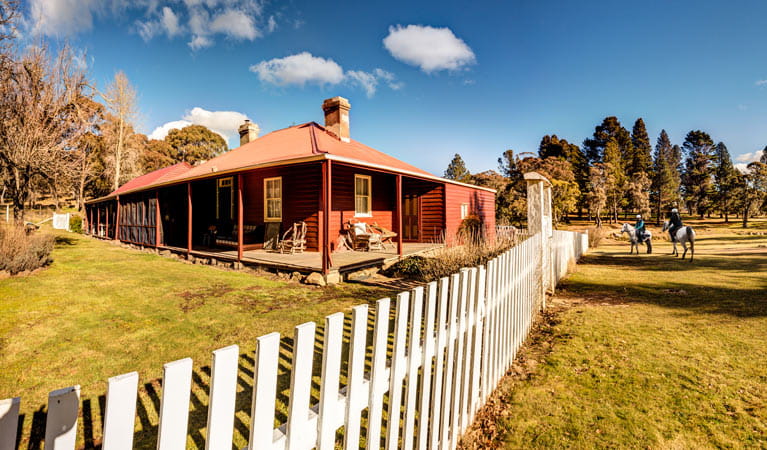High Plains area
Kosciuszko National Park
Extended closure in 2024
This area will be closed from 4 April 2024 to 4 October 2024 (inclusive) for critical feral pest control operations. Read more about this closure.
Overview
The High Plains area spoils you with summer walks, horse rides and bike trails to mountain huts, caves and gorges. Camp, stay in Currango’s heritage cottages, and discover Kosciuszko’s wild north-east corner.
Read more about High Plains area
Venture off the Snowy Mountains Highway, between Tumut and Cooma, to discover this remote but rewarding corner of Kosciuszko National Park.
In summer, camp at popular Blue Waterholes campground. Try one of the horse-friendly campgrounds, like Ghost Gully campground on Long Plain. Explore the treeless plains, snow grass valleys and mountain woodland. Or visit the limestone gorges, caves and waterfall along Clarke Gorge walk or Nichols Gorge walk.
Mosquito Run is a favourite with mountain bikers and horse riders, taking in historic Hainsworth Hut and Old Currango Homestead. Enjoy the views from Batlow Rocks at Tantangara Dam, or from Tantangara Mountain near Rocky Plains. You can even try part of the epic Australian Alps walking track or National trail which pass through this area, visiting Oldfields Hut on Murray Gap trail.
For a real taste of this area’s rich colonial heritage, rustic Currango Homestead and its charming cottages offer group or exclusive accommodation.
Nearby, Tantangara Dam is a popular summer spot for fishing and boating. Yarrangobilly Caves is less than an hour away.
Local alerts
For the latest updates on fires, closures and other alerts in this area, see https://www.nationalparks.nsw.gov.au/visit-a-park/parks/high-plains-area/local-alerts
Map
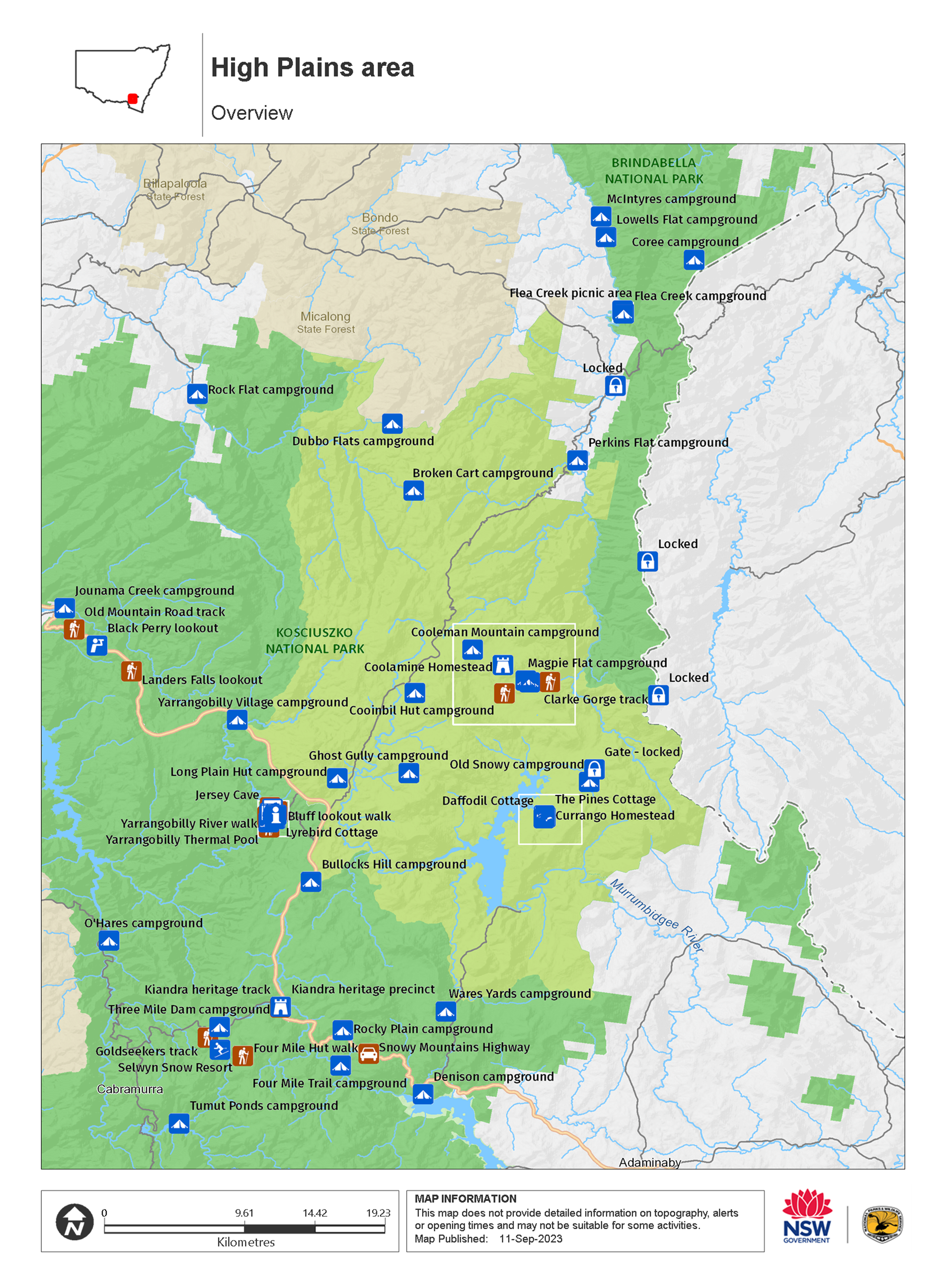
Map
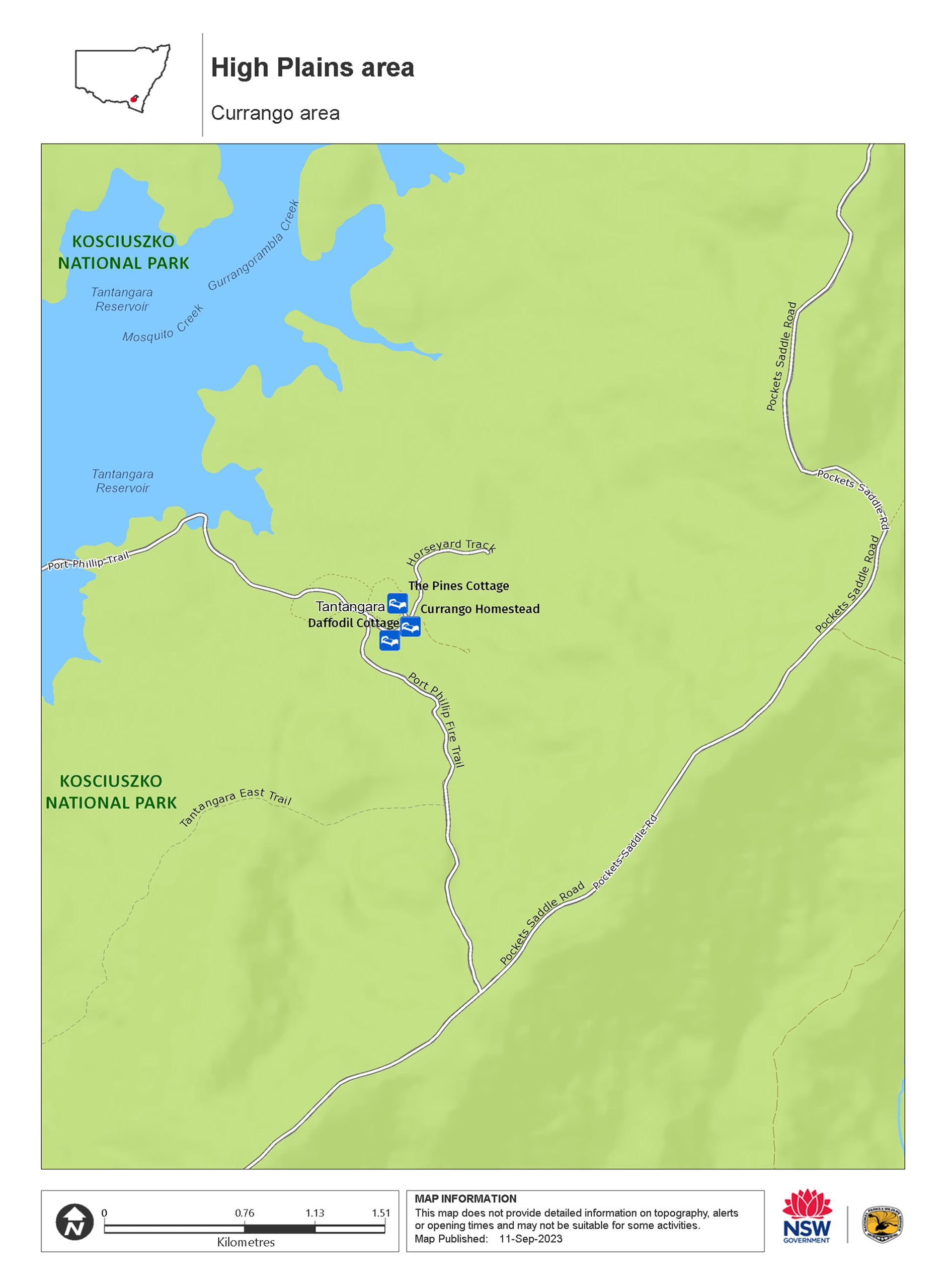
Map
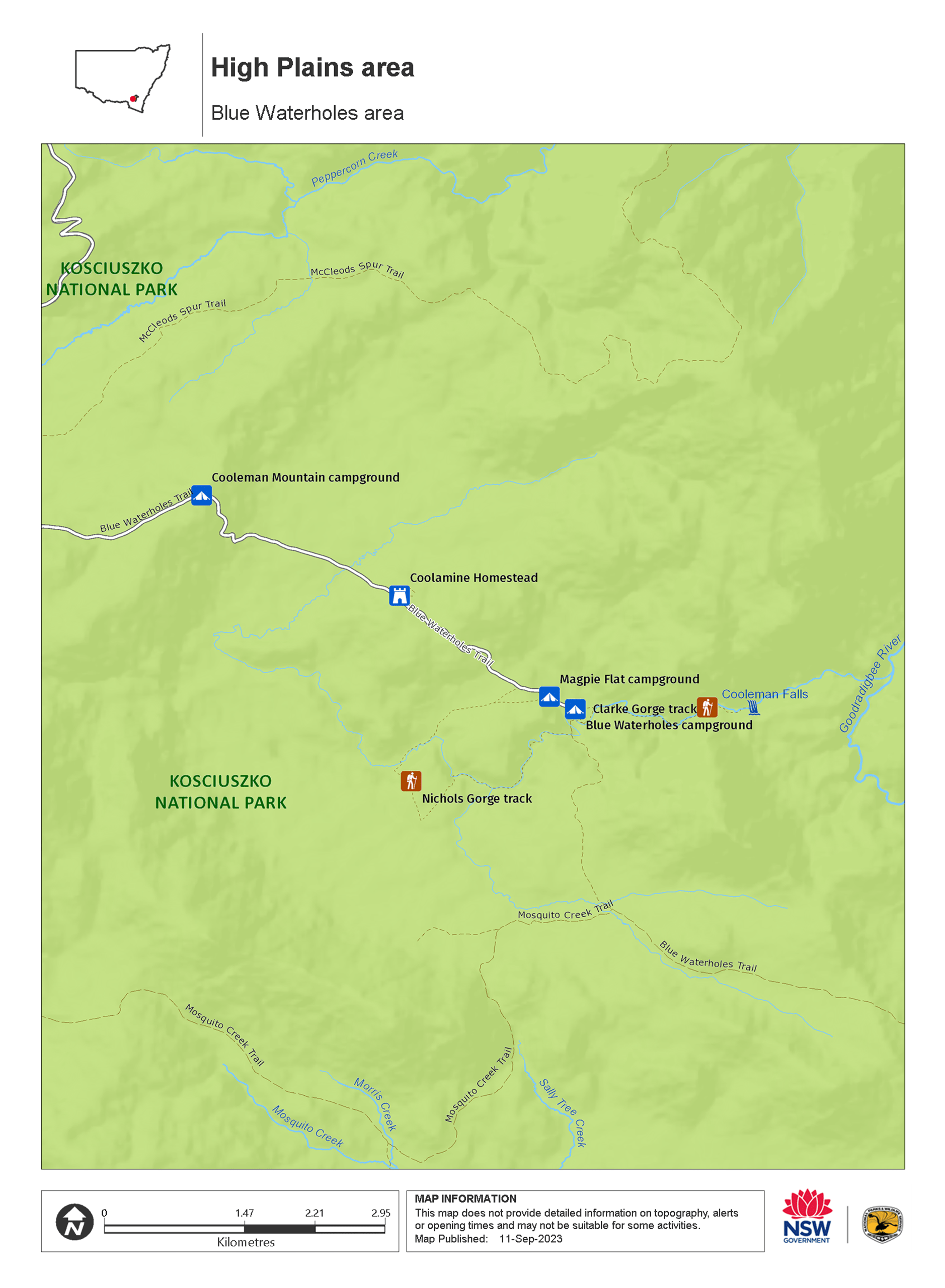
Map legend

Contact
- in Kosciuszko National Park in the Snowy Mountains region
Long Plain Road and Tantangara Road (beyond the dam wall) are closed in winter from June to October long weekends. This period may be extended so it’s a good idea to contact the Tumut Visitor Centre. Areas may have to close at times due to poor weather or fire danger.
-
No park entry fees apply in the High Plains area. See vehicle entry fees for other areas in Kosciuszko National Park.
Buy annual pass. -
-
Tumut Region Visitor Centre
02 6947 7025
Contact hours: 9am to 5pm daily. Closed Christmas Day. - The Old Butter Factory, 5 Adelong Road, Tumut NSW 2720
-
Email: tumutrvc@environment.nsw.gov.au
-
Tumut Region Visitor Centre
Visitor info
All the practical information you need to know about the High Plains area.
Getting there and parking
To get to the High Plains area of Kosciuszko National Park:
Access from Tumut:
- Take Snowy Mountains Highway south
- Long Plain Road is around 75km from Tumut
- Tantangara Road is around 110km from Tumut
Access from Cooma:
- Take Snowy Mountains Highway via Adaminaby
- Tantangara Road is around 85km from Cooma
- Long Plain Road is around 124km from Cooma
The nearest fuel and supplies are located in Adaminaby, Cooma, Talbingo, or Tumut. Limited services in Cabramurra.
Parking
- Blue Waterholes campground See on map
- Cooinbil Hut campground See on map
Road quality
Road closures
- Long Plain Road and Tantangara Road (beyond the dam wall) are closed in winter. There's no winter access to Currango or Blue Waterholes areas.
- Check weather and road conditions before you set out as unsealed roads can become boggy.
- Tantangara Causeway, on Port Phillip trail, can close due to flooding. Contact the Tumut Visitor Centre before you set out.
Snow chains
The Roads and Maritime Service (RMS) recommends snow chains are carried by all vehicles driving in the park in winter, including 4WD and AWD, in the event of extreme weather. Visit the Live Traffic website for current conditions.
Best times to visit
The vast and varied High Plains area is packed with activities and attractions, during the warmer months. Here are some of the highlights.
Autumn
Enjoy the crisp mountain air and purple-tinged heath on a heart-pumping bike adventure, horse ride or walk. Try easy Pocket ride to Pockets Hut, moderate Plain ride, or the challenging Gavels Circuit. Rise early to climb Batlow Rocks and watch the mist rise off the valley. Throw a fishing line in Tantagara Dam or the waters of the Murrumbidgee River, then warm up by the campfire under a sky full of stars.
Spring
In spring and summer, many of the slopes surrounding the high plains are covered in bright wildflowers. Set up camp and unload your mountain bike, saddle up the horses, or lace up your hiking boots. Discover Coolamine Homestead along Blue Waterholes trail, or Hains Hut on the 39km return Nungar Bullock ride. Follow Murrumbidgee ride to Townsend Hut, Pedens Hut and the wonderfully-named Love Nest in the Sallees. Experienced hikers who are well-prepared will find landscapes mostly unchanged by modern human activity in the vast Bimberi and Goobarragandra wilderness areas.
Summer
Escape the heat and head for the high plains. Why not enjoy a digital detox at Currango’s cottages, where you can relax on the verandah as the resident roos lounge on the lawns and the sun turns the plains gold. Base yourself at one of the many designated campgrounds in this area and relish the network of walks, rides, and scenic drives. Bring your boat and fishing gear to see what’s biting at Tantangara Dam. Lower water levels make this a great time to paddle or swim in a mountain stream, or tackle the river crossings on the walks to Clarke or Nichols Gorge.
Facilities
Toilets Show more
- Blue Waterholes campground
- Cooinbil Hut campground
- Cooleman Mountain campground
- Currango Homestead
- Daffodil Cottage
- Ghost Gully campground
- Long Plain Hut campground
- Old Snowy campground
- The Pines Cottage
Picnic tables
- Blue Waterholes campground
- Cooleman Mountain campground
- Daffodil Cottage
- Long Plain Hut campground
- The Pines Cottage
Barbecue facilities Show more
Drinking water
Showers
Maps and downloads
Fees and passes
No park entry fees apply in the High Plains area. See vehicle entry fees for other areas in Kosciuszko National Park.
Annual passes and entry fees (https://www.nationalparks.nsw.gov.au/passes-and-fees)
Permitted
- Mountain biking and horse riding are permitted on all public roads and most management trails in the High Plains area, except wilderness areas. Please stay on established trails. Bike riders should give way to walkers and horse riders.
- Caving: 4 wild caves are open to visitors in the Blue Waterholes area. These include: Murray Cave, Barbers Cave, Cooleman Cave, and Right Cooleman Cave. All other caves within the area require permits to visit.
Camping
Vehicle based camping is permitted only at designated campgrounds. Huts can be used for emergency shelter only. Campgrounds with facilities to camp with horses include: Cooinbil Hut, Long Plain Hut, Ghost Gully, Old Snowy, Wares Yards, Rocky Plain, and Bullocks Hill campgrounds.
Fishing
You can fish in rivers and streams between the October and June long weekends. A current NSW recreational fishing licence is required to fish in all waters. Fishing in dams and lakes is permitted year-round, but some waterways may close temporarily or have restrictions. Refer to the NSW Recreational Freshwater Fishing Guide for information.
Prohibited
- Vehicles, mountain bikes and horse riding aren't permitted in Clarke Gorge or Nichols Gorge at Blue Waterholes, or in wilderness areas.
- Firearms, chainsaws and fossicking aren't permitted in Kosciuszko National Park.
Drones
Flying a drone for recreational purposes is prohibited in this area. Drones may affect public enjoyment, safety and privacy, interfere with park operations, or pose a threat to wildlife. See the Drones in Parks policy.
This area may be a declared Drone Exclusion Zone, or may be subject to Civil Aviation Safety Authority (CASA) rules for flying near airports, aerodromes and helicopter landing sites. See CASA's Drone Flyer Rules.
Commercial filming and photography
Commercial filming or photography is prohibited without prior consent. You must apply for permission and contact the local office.
Pets
Pets and domestic animals (other than certified assistance animals) are not permitted. Find out which regional parks allow dog walking and see the pets in parks policy for more information.
Smoking
NSW national parks are no smoking areas. The alpine resorts of Selwyn, Thredbo, Perisher, Charlotte Pass, Ski Rider and Kosciuszko Tourist Park are exempt, though some commercial and outdoor places within these resorts may have no smoking areas.
Nearby towns
Adaminaby (19 km)
Visit the fascinating Snowy Scheme Museum at Adaminaby to learn about the Snowy Mountains Hydro-electric Scheme. Find out about the achievements of the engineers, the workers, the machinery and the role the project played in the development of the modern Australian nation. The museum is open on weekends.
Talbingo (37 km)
Talbingo is surrounded by some of the most inspiring scenery in the Snowy Mountains. At Talbingo Dam you'll enjoy panoramic views of the region as well as superb fishing for brown and rainbow trout. You can even go water-skiing on the dam.
Tumut (75 km)
Tumut is a country town on the northern foothills of the Snowy Mountains. The Rolling valleys, mountain streams and alpine mountain ranges make it popular for nature lovers and adventure enthusiasts.
Cooma (85 km)
The Snowy Hydro Discovery Centre is a state-of-the-art visitor facility showcasing the story of the Snowy Mountains Hydro-Electric Scheme from the early construction days to the role the scheme plays today in the development of Australia.
Learn more
High Plains area is a special place. Here are just some of the reasons why:
Unique landscapes
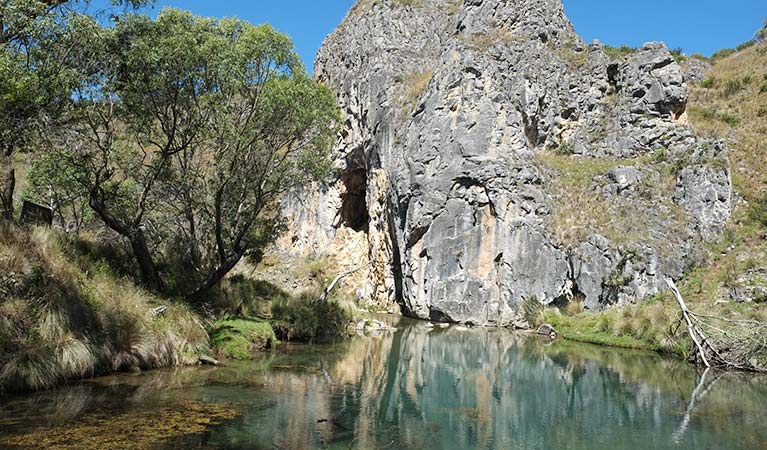
As you explore the High Plains area you’ll see plains of snow grass, herbs and heath. Snow gums and black sallee eucalypts dominate the woodland, while mountain gum, candle bark and alpine ash also appear at higher elevations. The karst environment of the Cooleman Plain is best seen in the steep cliffs, narrow gorges, limestone caves and remarkable blue-tinged spring around Blue Waterholes.
- Clarke Gorge walking track The 5km Clarke Gorge walking track follows Cave Creek downstream through limestone gorges and cave formations. Stop along the way to do some fishing and birdwatching.
- Nichols Gorge walking track The 7km Nichols Gorge walking track, suitable for experienced hikers, follows Cave Creek and passes some karst features before rejoining Blue Waterholes trail.
- Snowy Mountains adventures with Cochran Horse Treks Join Cochran Horse Treks for an unforgettable adventure in Kosciuszko National Park. Their 3 to 7-day guided tours are a great way to experience stunning Snowy Mountains landscapes on horseback.
High country huts and heritage
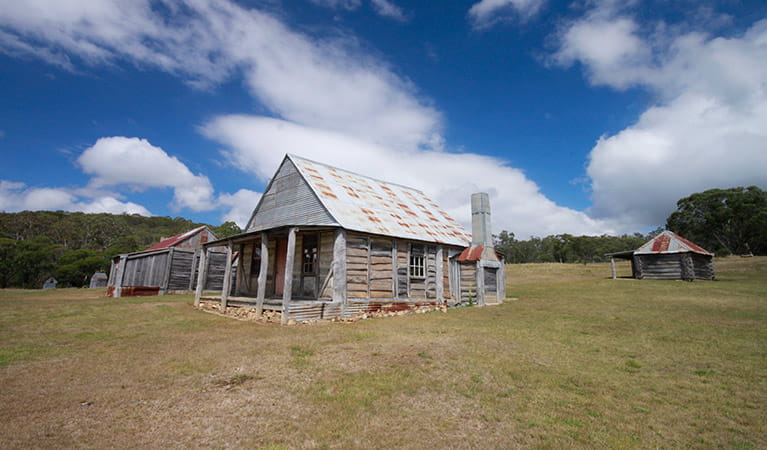
From the mid-1800s into the 1950s, the high plains of Kosciuszko National Park attracted summer graziers who constructed timber and tin huts as shelter throughout the area. More than 20 of these photogenic high country huts are dotted along the many tracks and trails of the plains. Larger properties, like Currango or Coolamine Homesteads, became permanent residences and now provide a fascinating window into pioneer life.
A wonderland for wildlife
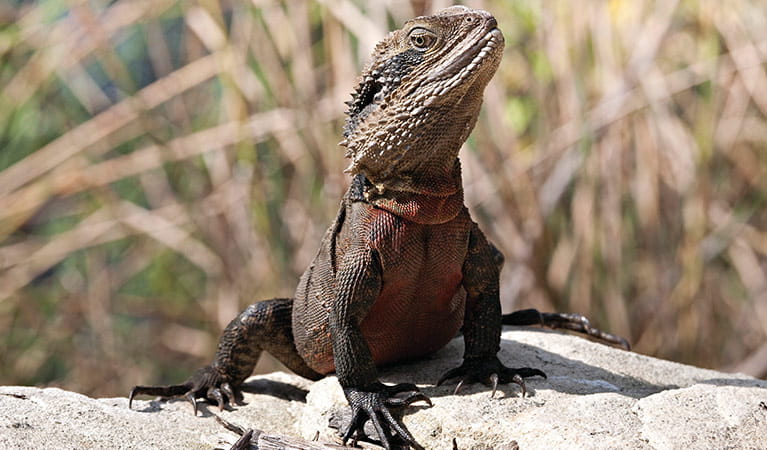
The complex karst environment of Cooleman Plain supports a rich community of animals and plants. Platypus, wombats, brushtail and ringtail possums, eastern grey kangaroos and red-necked wallabies are commonly seen along tracks and at campgrounds. The caves provide an important roosting site for the vulnerable eastern bentwing bat, and winter refuge for one of Australia’s highest populations of eastern water dragons. Keep an eye out for the leafy anchor plant along the banks of Cave Creek - it’s one of Australia’s only deciduous native plants.
- Clarke Gorge walking track The 5km Clarke Gorge walking track follows Cave Creek downstream through limestone gorges and cave formations. Stop along the way to do some fishing and birdwatching.
Experiences and facilities
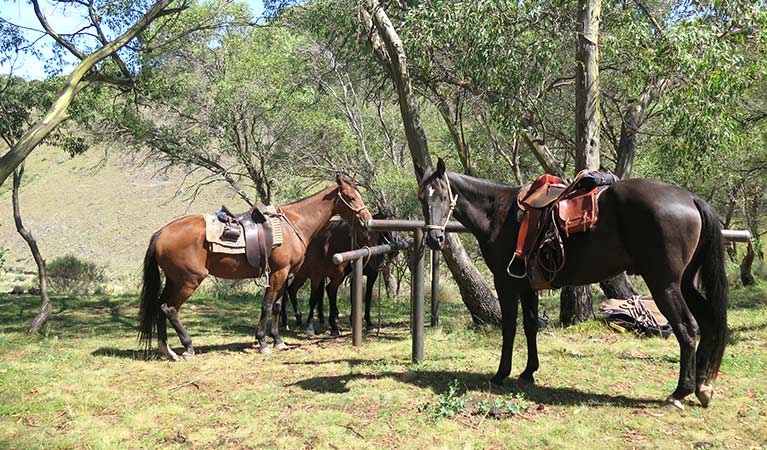
The vast grassland plains, with their hidden huts, are a superb backdrop for walking tracks, mountain bike trails and scenic drives. Blue Waterholes campground is a favourite summer destination to explore stunning walks, creeks, and gorges. There are plenty of campgrounds to choose from across the plains, and with horse riding popular here, many offer facilities for camping with horses. These include: Cooinbil Hut, Long Plain Hut, Ghost Gully, Old Snowy, Wares Yards, Rocky Plain, and Bullocks Hill campgrounds. You can also bring your horse if you’re staying at Currango Homestead, Daffodil Cottage or The Pines Cottage (fees and limits apply, bookings required).
World-class wilderness
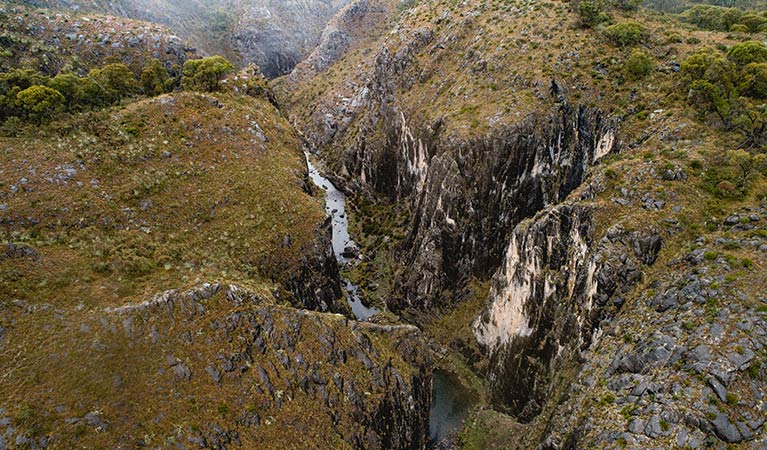
In recognition of Kosciuszko's unique value as a conservation area, it's been named a UNESCO Biosphere Reserve. More than half the area of the park, over 350,000ha, has been declared wilderness and includes the Goobarragandra, Bramina and Bimberi wilderness areas, which cover 61,500ha.
- Snowy Mountains adventures with Cochran Horse Treks Join Cochran Horse Treks for an unforgettable adventure in Kosciuszko National Park. Their 3 to 7-day guided tours are a great way to experience stunning Snowy Mountains landscapes on horseback.
- Snowy Mountains multi-day horse ride treks Immerse yourself in the wild beauty of the Snowy Mountains on a multi-day horse riding trek guided and supported by Reynella Rides. You'll enjoy hearty mountain food and roomy tents as you explore the High Plains area in Kosciuszko National Park.
Plants and animals protected in this park
Animals
-
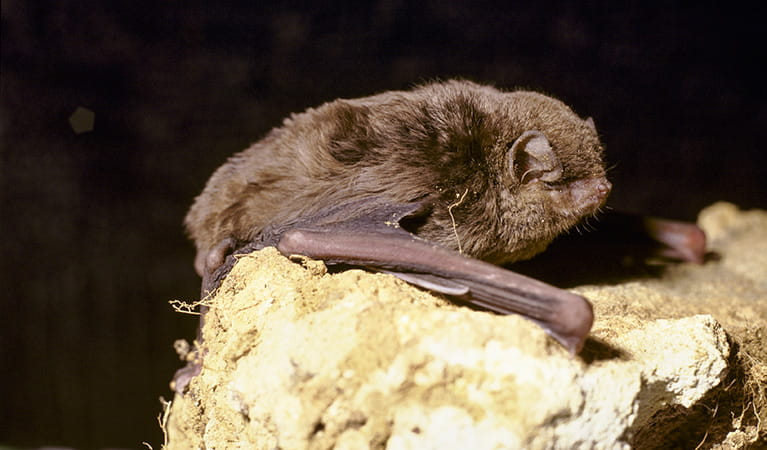
Eastern bentwing-bat (Miniopterus schreibersii oceanensis)
Eastern bentwing-bats congregate in caves across the east and north-west coasts of Australia, in colonies of up to 150,000. These small Australian animals weigh around 13-17g and can reach speeds of up to 50km per hour. Eastern bentwing-bats use both sight and echolocation to catch small insects mid-air.
-

Swamp wallaby (Wallabia bicolor)
The swamp wallaby, also known as the black wallaby or black pademelon, lives in the dense understorey of rainforests, woodlands and dry sclerophyll forest along eastern Australia. This unique Australian macropod has a dark black-grey coat with a distinctive light-coloured cheek stripe.
-

Common ringtail possum (Pseudocheirus peregrinus)
Commonly found in forests, woodlands and leafy gardens across eastern NSW, the Australian ringtail possum is a tree-dwelling marsupial. With a powerful tail perfectly adapted to grasp objects, it forages in trees for eucalypt leaves, flowers and fruit.
-

Superb lyrebird (Menura novaehollandiae)
With a complex mimicking call and an elaborate courtship dance to match, the superb lyrebird is one of the most spectacular Australian animals. A bird watching must-see, the superb lyrebird can be found in rainforests and wet woodlands across eastern NSW and Victoria.
-
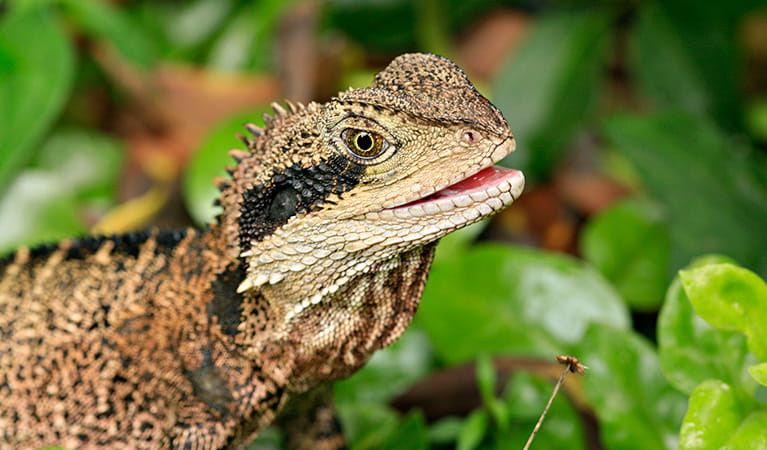
Eastern water dragon (Intellagama lesueurii lesueurii)
The eastern water dragon is a subaquatic lizard found in healthy waterways along eastern NSW, from Nowra to halfway up the Cape York Pensinsula. It’s believed to be one of the oldest of Australian reptiles, remaining virtually unchanged for over 20 million years.
-

Bare-nosed wombat (Vombatus ursinus)
A large, squat marsupial, the Australian bare-nosed wombat is a burrowing mammal found in coastal forests and mountain ranges across NSW and Victoria. The only other remaining species of wombat in NSW, the endangered southern hairy-nosed wombat, was considered extinct until relatively recently.
-
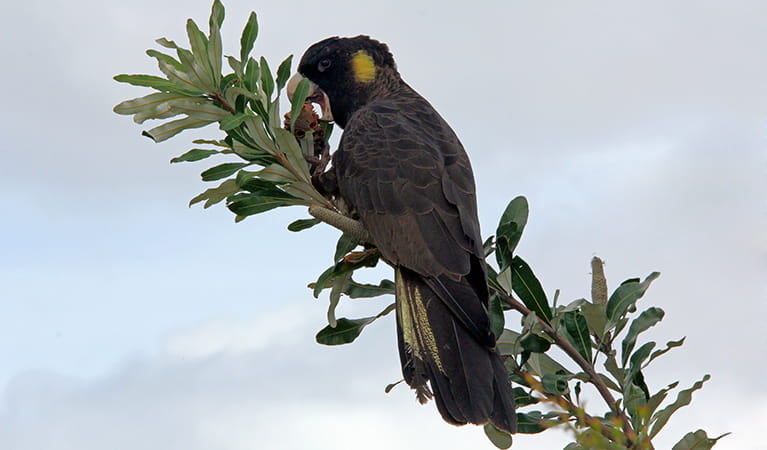
Yellow-tailed black cockatoo (Calyptorhynchus funereus)
The yellow-tailed black cockatoo is one of the largest species of parrot. With dusty-black plumage, they have a yellow tail and cheek patch. They’re easily spotted while bird watching, as they feed on seeds in native forests and pine plantations.
-
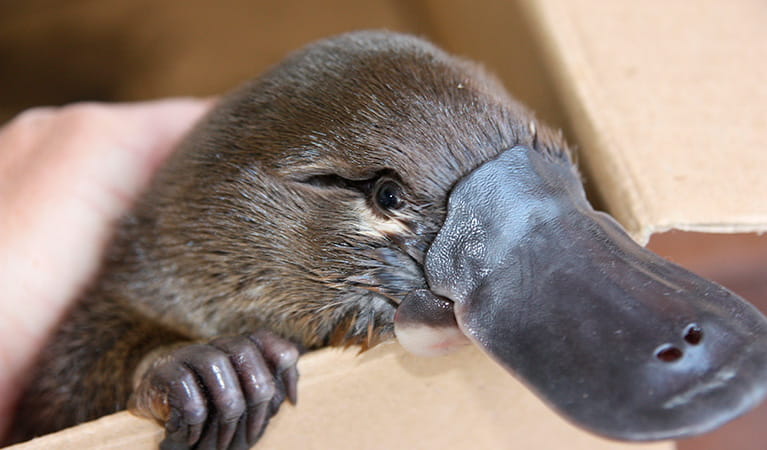
Platypus (Ornithorhynchus anatinus)
One of the most fascinating and unusual Australian animals, the duck-billed platypus, along with the echidna, are the only known monotremes, or egg-laying mammals, in existence. The platypus is generally found in permanent river systems and lakes in southern and eastern NSW and east and west of the Great Dividing Range.
-
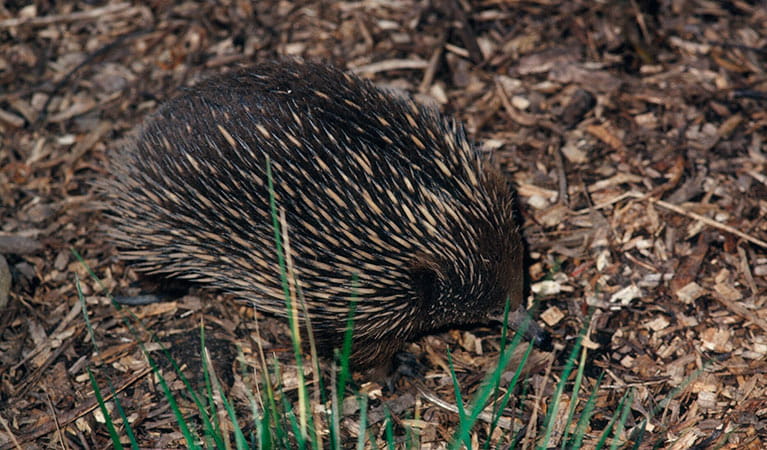
Short-beaked echidna (Tachyglossus aculeatus)
One of only 2 egg-laying mammals in the world, the short-beaked echidna is one of the most widespread of Australian native animals. Covered in spines, or quills, they’re equipped with a keen sense of smell and a tube-like snout which they use to break apart termite mounds in search of ants.
-
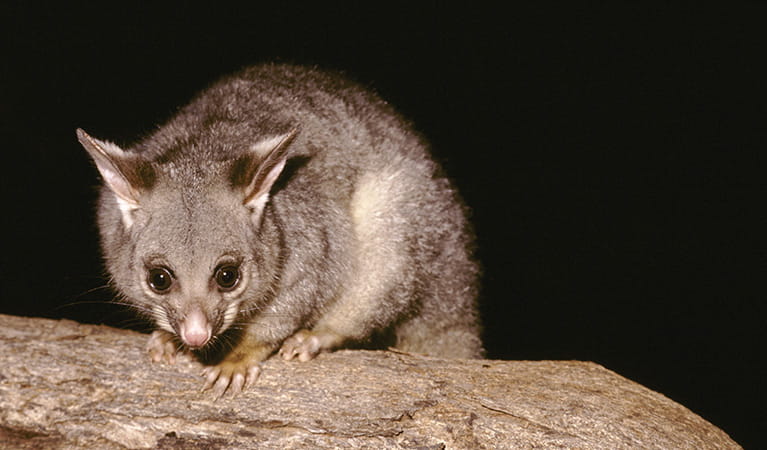
Common brushtail possum (Trichosurus vulpecula)
One of the most widespread of Australian tree-dwelling marsupials, the common brushtail possum is found across most of NSW in woodlands, rainforests and urban areas. With strong claws, a prehensile tail and opposable digits, these native Australian animals are well-adapted for life amongst the trees.
Environments in this area
What we're doing
High Plains area has management strategies in place to protect and conserve the values of this park. Visit the OEH website for detailed park and fire management documents. Here is just some of the work we’re doing to conserve these values:
Understanding landscapes and geology
Geo conservation efforts and research play an important role in protecting the delicate ecosystems of Kosciuszko National Park, such as the Cooleman Karst Plain. Rehabilitation and maintenance works to limit the impact of erosion and degradation, and monitoring the effects of climate change and visitation, are ongoing.
Preserving biodiversity
Kosciuszko National Park plays and important role in conserving NSW’s biodiversity by protecting its vulnerable, threatened and endangered species. Conservation activities are carried out in this park, and include monitoring the habitat, distribution and population of the northern corroboree frog, broad-toothed rat, and Max Muellers burr-daisy.
Managing weeds, pest animals and other threats
Pests and weeds have a significant impact on the ecosystems and habitats within Kosciuszko National Park. Reduction of species such as ox-eye daisy are an important part of the work NSW National Parks and Wildlife Service (NPWS) does to protect the integrity of the High Plains area.
Preserving historic heritage
The historic heritage of Kosciuszko National Park is preserved through a variety of NPWS programs that embrace its past. Heritage revitalisation and adaptive reuse projects are ongoing in this park. NPWS also works with volunteer groups including the Kosciuszko Huts Association, Friends of Currango and 4WD clubs to preserve and maintain historic huts in the High Plains area.
Developing visitor facilities and experiences
NPWS is committed to developing facilities for the enjoyment and safety of visitors to Kosciuszko National Park. Visitor feedback and environmental sustainability are key considerations in park maintenance, and upgrades are ongoing. Heritage cottages, campgrounds, picnic areas, and trails are continually maintained and upgraded, and NPWS regularly reviews the park’s recreational opportunities, identifying areas for improvement or addition. Hazard assessments are also ongoing.
Kosciuszko National Park has achieved Australia’s first Ecotourism Destination Certification, through Ecotourism Australia, recognising best practice sustainable tourism and visitation in protected areas.
Managing fire
NSW is one of the most bushfire prone areas in the world due to our climate, weather systems, vegetation and the rugged terrain. NPWS is committed to maintaining natural and cultural heritage values and minimising the likelihood and impact of bushfires via a strategic program of fire research, fire planning, hazard reduction, highly trained rapid response firefighting crews and community alerts.

